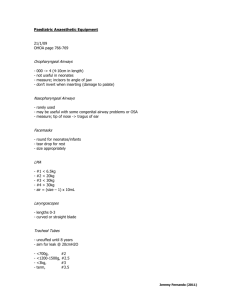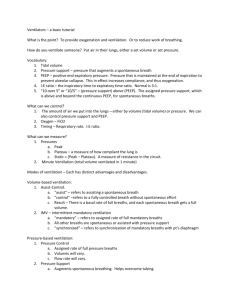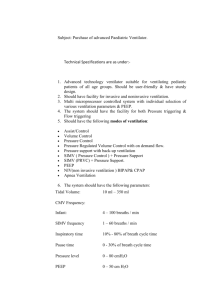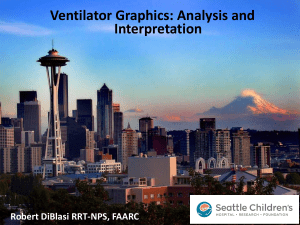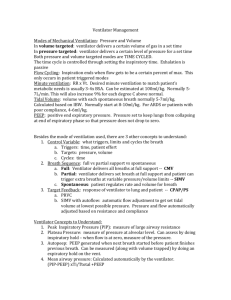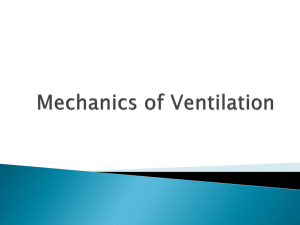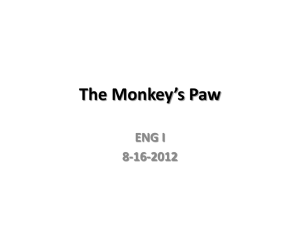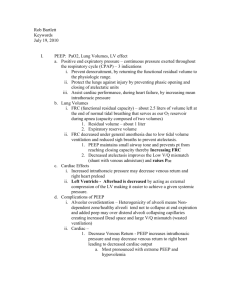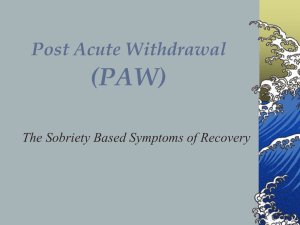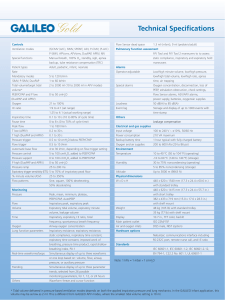graphics pres
advertisement
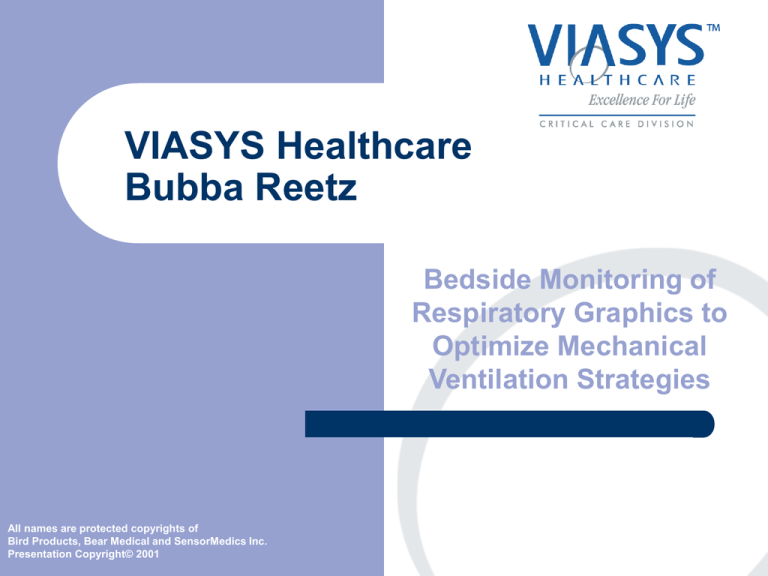
VIASYS Healthcare Bubba Reetz Bedside Monitoring of Respiratory Graphics to Optimize Mechanical Ventilation Strategies All names are protected copyrights of Bird Products, Bear Medical and SensorMedics Inc. Presentation Copyright© 2001 Run Lungs Run Primary Goals Early identification of changes in patient’s condition Optimize ventilator performance and fine-tune the ventilator settings Determine the effectiveness of ventilation support Early detection of possible adverse effects of mechanical ventilation Minimize the risk of ventilator-induced complications or ventilator malfunctioning Basic Mechanism of PPV Pressure Difference Gas Flow Time Volume Change What is measured? Pressure Time Flow (dV /dt ) Volume Flow Volume (calculated) time Pneumotachographs Fleisch Pneumotachograph – Orifice Pneumotachograph – – Measures pressure drop across a known resistance Fixed or Variable Vortex Pneumotachograph – Capillary tubes and pressure transducer Ultrasonic detection of created turbulence Turbine Pneumotachograph – Photocell detects rotation of turbine Fixed Orifice Pneumotach Q P1 R D P =Q x R Q = (P1 - P2) / R DV=QxDt P2 Heated Anemometers Heated element (wire or film) – Measures the current necessary to maintain the temperature constant (cooling effect of gas flow) Lack of moving parts Fast and sensitive response Virtually no resistance + - Problems of flow measurement Moisture Secretion Ambient temperature Humidity Altitude Placement of the sensor Compressible volume loss What is Displayed? Real-time waveforms of – – – Loops – – Proximal Airway Pressure Insp. / Expiratory Flow Rate Insp. / Expiratory Tidal Volume Pressure / Volume Flow / Volume Calculated Parameters – – – Compliance, Resistance, TC, C20 / Cdyn Work of breathing Waveforms PIP Pressure PEEP + 0 _ Insp. Flow Volume Exp. Insp. Exp. Time Loops Volume Flow Expir. Insp. Insp. Pressure Expir. Volume Phase Variables A/ Trigger: – – C B/ Limit: – – – Patient (assisted) Machine (controlled) C/ Cycle: – – – B Flow Pressure Volume Volume Time Flow A Control variables Volume Ventilation Pressure Pressure Flow Pressure Ventilation time Flow time Volume Ventilation - Waveforms Inspiratory Hold Flow Tinsp PIP Pressure Plateau Pressure PEEP Volume Cycled Time Cycled Pressure Ventilation - Waveforms Peak Flow 25% Flow PIP Tinsp. Pressure Pressure Control Pressure Support Pressure-Volume Loops Volume Volume Pressure Pressure Flow-Volume Loops Flow Flow Volume Volume Continuous Mandatory Ventilation Control: Only machine initiated mandatory breaths: Paw Assist: Only patient initiated mandatory breaths: Paw Assist/Control: machine and patient initiated breaths: Paw Typical P-V Loops Volume Pressure Controlled Volume Pressure Assisted Volume Pressure Spontaneous Intermittent Mandatory Ventilation IMV: Machine initiated + Spontaneous breaths Paw SIMV: Mandatory (patient or machine initiated) + Spontaneous breaths Paw Spontaneous Modes Continuous Positive Airway Pressure Paw CPAP Pressure Support Ventilation Paw PS SIMV + Pressure Support Pressure supported spontaneous + Patient, or machine-initiated mandatory breaths Paw Abnormalities Detection of air-leak Over-distension - Gas trapping Increased expiratory resistance Inspiratory time adjustment Airway obstruction Patient-ventilator dysynchrony Inadequate trigger sensitivity Inadequate flow support Inadequate PEEP Airleak Volume Time Volume Flow Volume Pressure Increased Expiratory Resistance Prolonged expiratory flow indicates an obstruction to exhalation and may be caused by obstruction of a large airway, bronchospasm, or expiratory valve failure of the ventilator Flow Time Normal Resistance Increased Resistance Insufficient Expiratory Time Expiratory flow is unable to return to baseline prior to the initiation of the next mechanical breath Incomplete exhalation causes gas trapping, dynamic hyper-expansion and the development of intrinsic PEEP Flow Time End-Expiratory Flow Airway Obstruction F F V V Before Suction After Suction Optimising PEEP V V P PEEP: 3 cmH2O P PEEP: 8 cmH2O Trigger Sensitivity Pressure Time Sensitivity level Flow Time Atelectasis Lost FRC Replaced FRC V V P P Overdistension Overdistension occurs when the volume limit of some components of the lung has been exceeded Abrupt decrease in compliance at the termination of inspiration Results in a terminal “Beaking” of the P/V Loop Volume Pressure Mental Break Assessment of static P-V curve Super-syringe method: Stepwise inflation from a big syringe with multiple occlusions at each volumes to record recoil pressure – – – – – Volume Time consuming Cumbersome to perform Difficult to standardize Patient must be paralysed, connected to a special equipment Great risk of oxygen desaturation Pressure Slow Flow Single Inflation Method Slow (5-10 lpm) inspiratory flow with large Vt and ZEEP Volume The inspiratory curve of the dynamic P-V loop closely approximates the static curve The flow-resistive pressure component could be subtracted Easy to perform, fast and relatively comfortable UPIflex LPIflex Servillo: AJRCCM 1997 Lu: AJRCCM 1999 Pressure Ventilation-Induced Lung Injury* Atelectrauma: Repetitive alveolar collapse and reopening of the under-recruited alveoli *Dreyfuss: J Appl Physiol 1992 Volutrauma: Over-distension of normally aerated alveoli due to excessive volume delivery Inflection Points on the P-V curve in ARF Upper Inflection Point: Represents pressure resulting in regional overdistension Volume UPIflex Lower Inflection Point: Represents minimal pressure for adequate alveolar recruitment LPIflex Pressure Lung Protective Strategy 1. 2. 3. Set PEEP above the lower Pflex to keep the lung open and avoid alveolar collapse Apply small Vt to minimize stretching forces Set Pplat below the upper Pflex to avoid regional overdistension Volume Pressure THANK YOU
